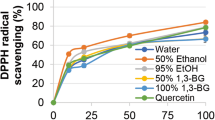Abstract
There is evidence that regulation of inflammatory cytokines is among the immunomodulatory effects of photochemotherapy with 8-MOP and UVA. We have recently demonstrated that in the monocytoid cell line U937 incubation with 8-MOP and subsequent exposure to UVA is able to efficiently downregulate the release of TNF-α into the culture supernatant. Chlorpromazine, a well known photosensitising drug, was even more potent with regard to this effect. Based on these observations, in this study we further investigate the mechanisms of TNF-α inhibition by 8-MOP and CPZ photosensitization. For this purpose we determined intracellular protein levels and gene expression of TNF-α by western blot and quantitative real-time PCR, respectively. Our results indicate that the observed inhibition of TNF-α secretion after photochemotherapy is not due to downregulation of gene transcription but rather to a post-transcriptional mechanism. The observed decrease of intracellular TNF-α with CPZ and 8-MOP points to decreased protein synthesis or enhanced degradation. These findings demonstrate that posttranscriptional regulation of cytokine expression is a possible mechanism of action of photochemotherapy.
Similar content being viewed by others
Reference
R. Knobler and P. Heald, Extracorporeal photoimmunochemotherapy, in Dermatological phototherapy and photodiagnostic methods, ed. J. Krutmann et al., Springer-Verlag, Berlin–Heidelberg, 2001, pp. 248–260
P. Neuner B. Charvat R. Knobler R. Kirnbauer A. Schwarz T. Luger T. Schwarz Cytokine release by peripheral blood mononuclear cells is affected by 8-methoxypsoralen plus UVA Photochem. Photobiol. 1994 59 182–188
Y. Tokura Modulation of cytokine production by 8-MOP and UVA J. Dermatol. Sci. 1999 19 114–122
B. R. Vowels C. Maureen M. H. Boufal L. J. Walsh A. H. Rook Extracorporeal photochemotherapy induces the production of tumor necrosis factor-a by monocytes: implication for treatment of cutaneous T-cell lymphoma and systemic sclerosis J. Invest. Dermatol. 1992 98 686–692
J. Vilcek T. H. Lee Tumor necrosis factor. New insights into the molecular mechanisms of its multiple actions J. Biol. Chem. 1991 266 7313–7316
K. J. Tracey A. C. Cerami Tumor necrosis factor, other cytokines and disease Annu. Rev. Cell Biol. 1993 9 317–343
F. Trautinger F. Hammerle A. G. Pöschl M. Micksche Respiratory burst capability of polymorphonuclear neutrophils and TNF-a serum levels in relationship to the development of septic syndrome in critically ill patients J. Leukocyte Biol. 1991 49 449–454
E. Gocke Review of the genotoxic properties of chlorpromazine and related phenothiazines Mutat. Res. 1996 366 9–21
R. D. Hall G. R. Buettner C. F. Chignell The biphotonic photoionization of chlorpromazine during conventional flash photolysis: spin trapping results with 5,5-dimethyl-1-pyrroline-N-oxide Photochem. Photobiol. 1991 54 167–173
H. P. van Iperen G. M. J. Beijersbergen van Henegouwen Chlorpromazine, a candidate drug for photopheresis J. Photochem. Photobiol., B: Biol. 1996 34 217–224
A. Wolnicka-Glubisz J. M. Rijnkels T. Sarna G. M. J. Beijersbergen van Henegouwen Apoptosis in leukocytes induced by UVA in the presence of 8-methoxypsoralen, chlorpromazine or 4,6,4’-trimethylangelicine J. Photochem. Photobiol., B: Biol. 2002 68 65–72
A. Wolnicka T. Sarna R. Knobler F. Trautinger Differential effect of 8-methoxypsoralen, 4,6,4’-trimethylangelicin, and chlorpromazine on cell death and TNF-alpha production Arch. Dermatol. Res. 2002 294 147–51
F. A. Roberts G. J. Richardson S. M. Michalek Effects of Porphyromonas gingivalis and Escherichia coli on mononuclear phagocytes Infect. Immun. 1997 65 3248–3254
C. Stratowa G. Löffler P. Lichter S. Stilgenbauer P. Haberl N. Schweifer H. Döhner K. K. Wilgenbus cDNA microarray gene expression analysis of B-cell chronic lymphocytic leukemia proposes potential new prognostic markers involved in lymphocyte trafficking Int. J. Cancer 2001 91 474–480
P. Stordeur L. F. Poulin L. Craciun L. Zhou L. Schandene A. De Lavareille S. Gorierly M. Goldman Cytokine mRNA quantification by real-time PCR J. Immunol. Methods 2002 259 25–64
Author information
Authors and Affiliations
Rights and permissions
About this article
Cite this article
Wolnicka-Glubisz, A., Sarna, T., Klosner, G. et al. UVA activated 8-MOP and chlorpromazine inhibit release of TNF-α by post-transcriptional regulation. Photochem Photobiol Sci 3, 334–336 (2004). https://doi.org/10.1039/b302621c
Received:
Accepted:
Published:
Issue Date:
DOI: https://doi.org/10.1039/b302621c




